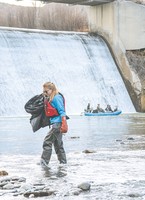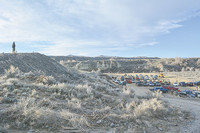Clear, 41° F
Tons of silt were released from behind the Willwood Dam in October, when the water levels were lowered to improve the structure. The sediment turned the river a grayish color, and some people feared that fish might have been wiped out for miles …
This item is available in full to subscribers.
The Powell Tribune has expanded its online content. To continue reading, you will need to either log in to your subscriber account, or purchase a subscription.
If you are a current print subscriber, you can set up a free web account by clicking here.
If you already have a web account, but need to reset it, you can do so by clicking here.
If you would like to purchase a subscription click here.
Please log in to continue |
|



Wide range of volunteers spend hours picking up trash in area
Thanks to some fresh water — and the elbow grease of around 80 volunteers — the Shoshone River is a whole lot cleaner than it was a few months ago.
Tons of silt were released from behind the Willwood Dam in October, when the water levels were lowered to improve the structure. The sediment turned the river a grayish color, and some people feared that fish might have been wiped out for miles below the dam.
But now, it appears things were not that bad.
“It looks like maybe the effects that were claimed maybe weren’t as detrimental as everybody was afraid of, including ourselves,” said Roger Smith, chairman of the Willwood Irrigation District board, which operates the dam. “We were worried about it, and I’m optimistic by what I saw today.”
Smith noted initial speculation — that all the fish may have been killed for a 30-mile stretch downstream — has proven to be incorrect.
Dave Sweet, with the Yellowstone Chapter of Trout Unlimited, was one of the people who had worried about fish being wiped out for dozens of miles. Now, Sweet is enthused by what he’s seeing.
“Time will tell, but so far, the indicators are really good that, you know, the river’s going to recover,” he said. “Rivers are pretty dynamic systems. They can weather a lot. So we’re hopeful.”
Smith and Sweet made those remarks Saturday as they and dozens of other volunteers worked to clean up the Shoshone River in the Willwood area — collecting tires, barrels and other trash that people have illegally discarded in or near the water over the years.
Beyond Trout Unlimited and the irrigation district, participants included representatives from the Wyoming Game and Fish Department, the Wyoming Department of Environmental Quality, Cody High School’s Outdoors Club, FFA members, the Greater Yellowstone Coalition and local residents who simply heard about the clean up and wanted to help.
“It also shows the tremendous support and love for this river that people have,” said Sweet.
Smith agreed, saying he was encouraged to see so many people concerned about the river.
He did add that he gets discouraged whenever people “go to a place of nature and leave garbage.”
“You know, it’s important for people to realize that when they throw this trash out and in the river, it ends up somewhere — where it ends up is usually at our dam, or along the riverbanks,” Smith said. “So the community needs to start being a little bit more conscientious about it.”
Smith was also pleased with how clear the Shoshone looked, even the river bottom.
Last fall, the Wyoming Department of Environmental Quality gave the Willwood Irrigation District a turbidity waiver to release some silt into the Shoshone downstream of the dam, allowing the district to replace the dam’s penstock and canal gate. But more silt than permitted was released, the DEQ has said. Fish were killed and the department issued a notice of violation.
Current reports indicate the fish population is down 10-20 percent, Smith said.
That’s better than expected, and Sweet said a significant population of trout and other fish survived.
“Whether they survived it by avoiding the sediment, by going up the tributaries, or whether they survived it just by staying in the river and weathering it out,” it’s great news, Sweet said.
There is concern about the chronic impacts of the sediment, beyond the immediate fish kill, he said.
“Sediment actually erodes the gills of fish, so there could be some long-term impacts on even those fish that survived,” Sweet said. “Then it’s the whole impact to the invertebrate population — the fish got to have something to eat.”
Sweet said he recently checked the river for invertebrate bugs and found some, “which is really good news.”
Over the past week and a half, the river ramped up, releasing 2,000 cubic feet per second (CFS) of water. Sweet said that in early April, the Bureau of Reclamation plans to release a flushing flow of 4,000 CFS, aimed at clearing out more of the sediment that settled in the area last fall.
Sweet said it’s “extremely fortunate” that the winter’s significant snowpack has allowed for the release of more water.
“If we were in a low-water year, we wouldn’t have the water to do that,” he said. “So the long-term impacts could have been significantly greater if that sediment had just sat in here and not been moved. We caught a break, you know — we caught a real break.”
To address the river’s current state — and look at future operations — three workgroups have formed, involving a host of state and local agencies.
The goal of the first workgroup is to deal with the trash and sediment in the river, which is what Saturday’s clean-up helped address.
The second workgroup is looking at the operations of the Willwood Dam to deal with the sediment that’s built up and “prevent this from happening again,” Sweet said. He said the silt will build up behind the dam again.
“In my mind, the highest priority of all is figuring how to reduce the sediment that comes down the river,” said Smith.
The third group is dealing with the sources of the sediment — where it’s coming from, how much is man-made and how much is natural. For the sediment that is man-made, the group is looking at how it can be mitigated or minimized through changes, ag practices or different land-use practices.
Those are longer-term projects, Sweet said, but “the good news is, there’s activity on all three (groups).”
Smith said he’s optimistic about the number of people who are working together toward what’s best for the river.
“We’re all for keeping the fishery there,” he said. “I believe in conserving nature as much as you can, but there has to be a compromise that works for everybody.”
He said they all share the same end goal.
“It’s just a matter of being realistic and, you know, it can’t always be just ‘my way.’ It’s got to be something that works for everyone,” Smith said.
(Tessa Baker contributed reporting.)